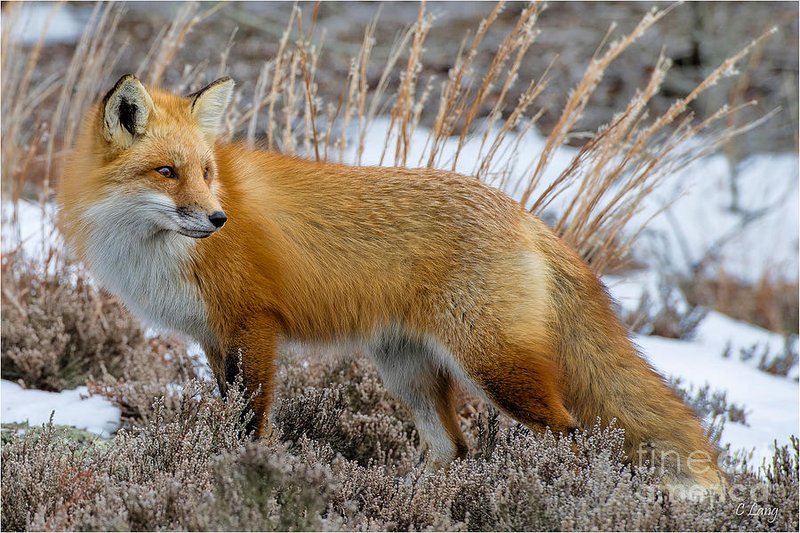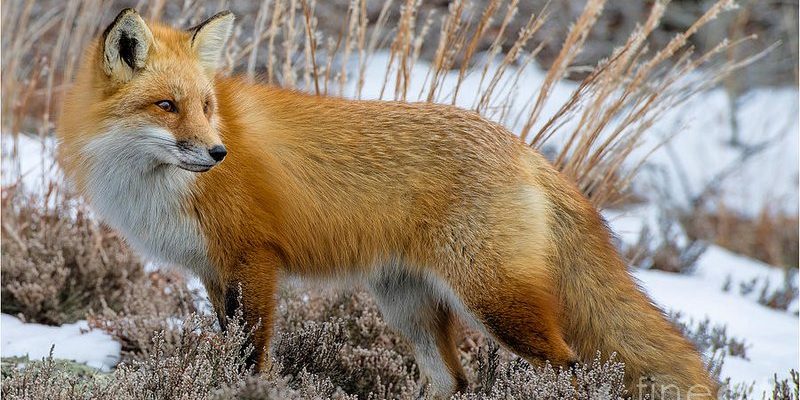
Have you ever spotted a flash of orange darting through the underbrush? That’s likely a Red Fox, one of the most adaptable and charming creatures in the wild. These clever canines are known for their striking appearance, intelligence, and playful behaviors. They often evoke images of cunning characters in storybooks, but there’s so much more to them than their clever reputation.
The Red Fox is not just a pretty face. They play a crucial role in their ecosystem, helping to control populations of rodents and other small animals. Their curious nature and distinctive vocalizations can bring a sense of intrigue to the natural world around us. Let’s dive deeper into the lives of these fascinating foxes and see what makes them tick!
Physical Characteristics
The Red Fox is easily recognizable thanks to its vibrant fur, bushy tail, and sharp features. Adult red foxes typically weigh between 8 to 15 pounds, standing about 12 to 15 inches tall at the shoulder. Their length, including the tail, can range from 24 to 30 inches. The fur is a rich reddish-orange color, with a white underbelly and a distinctive white tip on the tail. Their ears are pointed and black-tipped, which adds to their captivating look.
One notable feature of the Red Fox is its keen senses. Their eyesight is adapted for low-light conditions, allowing them to hunt effectively during twilight or nighttime. They can hear sounds from great distances, which helps them locate prey even underground. This remarkable adaptation showcases just how well-suited they are to their environments.
Interestingly, the overall appearance of a red fox can vary depending on its habitat. Foxes living in colder regions often have denser fur, while those in warmer climates may have shorter and lighter coats. This flexibility in their physical traits is a prime example of how Red Foxes have adapted to thrive in diverse environments across the globe.
Habitat and Distribution
Red Foxes are incredibly adaptable creatures. You’ll find them in a variety of habitats, including forests, grasslands, mountains, and even urban areas. They have a remarkable ability to live alongside humans, often foraging for food scraps in suburban neighborhoods. Their adaptability is one of the reasons they have such a wide distribution, spanning across North America, Europe, and Asia.
These foxes create dens in various locations, such as under fallen trees, rock crevices, or even in burrows abandoned by other animals. The dens serve as safe havens for raising their young, known as kits. Typically, a female Red Fox will give birth to a litter of 4 to 6 kits in the spring, and they’ll stay in the den for several weeks before venturing out.
When it comes to their territory, Red Foxes are known to establish home ranges that can be quite extensive, sometimes covering several square miles. Males often roam larger areas, while females tend to stick closer to their dens. This territorial behavior is essential for finding food and attracting mates, allowing them to thrive in both rural and urban settings.
Diet and Hunting Behaviors
As omnivores, Red Foxes have a varied diet that includes small mammals, birds, insects, fruits, and even plants. Their opportunistic feeding habits make them versatile hunters. They are especially skilled at catching rodents, which make up a significant part of their diet. Their keen senses and stealthy approach enable them to stalk their prey quietly before pouncing.
You might be surprised to learn that Red Foxes are also scavengers. They will often take advantage of leftovers from human activities, munching on everything from discarded takeout to garden produce. This adaptability in their diet helps them survive in different environments, especially in urban areas where traditional prey may not be as abundant.
Another interesting aspect of their hunting behavior is their unique pouncing technique. When they spot prey, they often leap into the air and land directly on it, delivering a swift conclusion to the hunt. This method is particularly effective in thick snow, where the fox can use the elements to its advantage. It’s a striking reminder of how beautifully adapted these creatures are to their surroundings.
Social Structure and Behavior
While Red Foxes are primarily solitary animals, they do exhibit social behaviors, especially during the breeding season. Males and females typically pair up for the breeding period, and their bond can last throughout the rearing of their young. They communicate through a variety of vocalizations, including barks, howls, and screams. Each sound serves a purpose, whether to attract mates or alert others of danger.
Playful behavior is also common among young foxes, who engage in wrestling and chasing games as they learn essential survival skills. Observing these interactions can be quite entertaining, as the kits display a range of energetic antics. As they grow, they learn how to hunt and navigate their territory more effectively.
Interestingly, foxes have a unique grooming ritual that involves licking and scratching themselves. This helps them maintain their fur, which is crucial for insulation and camouflage. Their social dynamics, combined with these grooming habits, illustrate the complex lives that Red Foxes lead.
Conservation Status
Overall, Red Foxes are not currently endangered and are classified as a species of least concern. However, their populations can be affected by habitat loss, hunting, and road accidents. Urban development can lead to a shrinking territory, forcing them to adapt or migrate to new areas. It’s crucial to create awareness about their role in the ecosystem and how humans can coexist with them.
Conservation efforts focus on habitat preservation and reducing road mortality rates, which pose significant threats to their survival. Programs aimed at educating the public on how to navigate living near these animals can help foster a more harmonious relationship. By protecting their habitats and understanding their behaviors, we can ensure that Red Foxes continue to thrive alongside us.
In some regions, hunting regulations help manage their populations, preventing overhunting while ensuring they remain a part of the natural balance. It’s a delicate dance of conservation, where human intervention can both help and hinder their survival.
Interesting Facts
| Scientific Name: | Vulpes vulpes |
| Size: | 8-15 pounds |
| Habitat: | Forests, grasslands, and urban areas |
| Diet: | Omnivorous: small mammals, birds, fruits |
| Speed: | Up to 30 mph |
| Lifespan: | 3-5 years in the wild, up to 10-12 in captivity |
| Social Structure: | Solitary, but form pairs during breeding |
FAQ
What do Red Foxes sound like?
Red Foxes are quite vocal, and their sounds can be startling if you hear them for the first time. They have a variety of calls, including barks, screams, and howls. Their scream, a high-pitched yelp, is often used to communicate with mates or signal danger. If you’ve ever heard a night filled with eerie, haunting sounds, there’s a good chance a red fox was nearby!
Can Red Foxes be pets?
While they are adorable, Red Foxes are wild animals and not suitable pets. They have specific needs that are difficult to meet in a home environment. Their instinctive behaviors, such as digging and marking territory, can lead to significant challenges for pet owners. Additionally, many areas have laws against keeping wild animals as pets. It’s best to admire these creatures in their natural habitat.
What do Red Foxes eat?
Red Foxes are omnivores, which means they eat both plants and animals. Their diet primarily consists of small mammals like mice and rabbits, but they also enjoy fruits, berries, and insects. This diverse diet allows them to adapt to different environments and seasonal food availability. In urban areas, they often scavenge for human food, which further broadens their diet.
Where do Red Foxes live?
Red Foxes are incredibly adaptable and can thrive in various habitats, including forests, grasslands, and even urban environments. They prefer areas with dense vegetation, which provides shelter and hunting grounds. In cities, they often find refuge in parks or residential gardens, displaying their remarkable ability to coexist with humans.
How fast can a Red Fox run?
Red Foxes can reach speeds of up to 30 miles per hour when sprinting. This speed is incredibly useful for both hunting and evading predators. Their agility and quick reflexes allow them to navigate through dense underbrush and escape threats swiftly, showcasing their survival instincts.
Do Red Foxes hibernate?
No, Red Foxes do not hibernate. Instead, they remain active throughout the year, adapting their hunting behaviors and diet to seasonal changes. During the colder months, they may rely more on their fat reserves and scavenging, but they stay alert and on the move, searching for food and maintaining their territories.
What is the breeding season for Red Foxes?
The breeding season for Red Foxes typically occurs from January to March. After a gestation period of about 53 days, the female gives birth to a litter of kits in the spring. The kits are born blind and helpless, relying entirely on their parents for care and protection during their early weeks.
Are Red Foxes dangerous to pets?
Generally, Red Foxes are not a significant threat to pets. However, they are opportunistic hunters and may prey on small animals, particularly if food is scarce. It’s wise to supervise small pets when outside, especially in areas known to have fox populations. Keeping pets on a leash or in secure yards can help prevent any potential issues.
How long do Red Foxes live?
In the wild, Red Foxes typically live around 3 to 5 years, though some can reach up to 10 or more in captivity due to the absence of threats like predators and diseases. Their lifespan can vary based on environmental conditions, availability of food, and human interactions.
What is the significance of Red Foxes in culture?
Red Foxes have held considerable significance in various cultures, often symbolizing cunning and intelligence. They appear in fables, folklore, and literature, showcasing their clever nature. In some Native American cultures, they are seen as tricksters, teaching important lessons about resourcefulness and adaptability.

